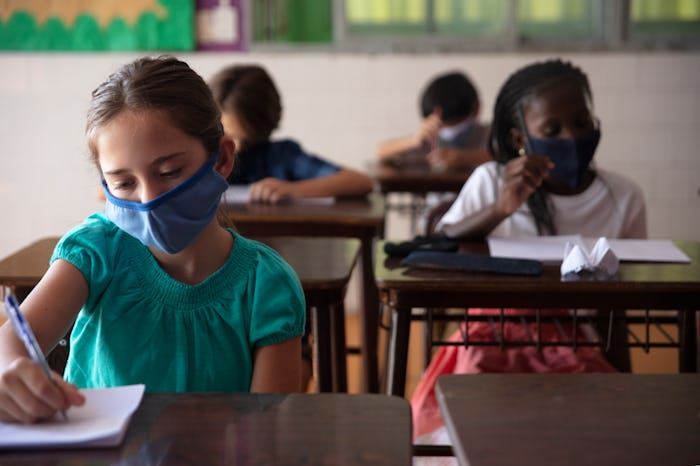News

AAP Urges Parents To Send Kids Back To School In Masks — Even If They’re Vaccinated
The American Academy of Pediatrics is encouraging a return to in-person learning with a layered approach to health and safety measures.
The American Academy of Pediatrics (AAP) is recommending parents put one item at the top of their children’s back-to-school supply shopping lists: face masks. The pediatrician group issued updated recommendations for reopening schools for the 2021-22 school year on Monday that prioritized in-person learning along with a layered approach to health and safety measures designed to limit the spread of the novel coronavirus. Along with recommending all eligible children receive COVID-19 vaccines, the AAP also noted all children over the age of 2 should still wear a face mask when in school regardless of their vaccination status.
“There are many children and others who cannot be vaccinated,” Dr. Sara Bode, chairperson elect of AAP’s Council on School Health Executive Committee, said in a statement released by the organization Monday. “This is why it’s important to use every tool in our toolkit to safeguard children from COVID-19. Universal masking is one of those tools and has been proven effective in protecting people against other respiratory diseases, as well.”
Currently, only children age 12 and older are eligible to receive a COVID-19 vaccination. And although children are generally thought to experience more mild cases of COVID than adults, they’re not immune from the virus. Data from the AAP and the Children’s Hospital Association has shown that, as of early July, more than 4 million children have tested positive for COVID-19 since the pandemic began in March of 2020. Overall, children account for 14.2% of COVID-19 cases.
According to the AAP, universal masking has been proven to reduce the transmission of COVID-19, making it an effective way for schools to limit the spread of the virus without having to monitor who is and isn’t vaccinated. In fact, Bode referred to universal masking as “the most effective strategy” schools could deploy “to create consistent messages and expectations among students without the added burden of needing to monitor everyone’s vaccination status.
In contrast, guidance issued earlier this month from the U.S. Centers for Disease Control and Prevention (CDC) recommended that masks be worn only by students who are not fully vaccinated and only when indoors. Of course, actual rules regarding face masks in schools will most likely be set at the state or county level and could even vary by district. As a result, parents and caregivers are encouraged to stay on top of how their state plans to address school mask policies.
Other recommendations included in the AAP’s updated school reopening guidance included advice that all those eligible for a COVID-19 vaccine, receive one. In general, the group urged schools and parents to take a layered approach to students’ return to in-person learning, combining vaccines with universal masking, increased ventilation, testing, quarantining when ill, and enhanced cleaning and disinfecting.
“Schools must continue to take a multi-pronged, layered approach to protect students, teachers, and staff,” the policy noted. “Combining these layers of protection will make in-person learning safe and possible.”
But above all else, the pediatrician group stressed that a return to in-person learning was vital for children. “We need to prioritize getting children back into schools alongside their friends and their teachers,” Dr. Sonja O’Leary, chair of AAP’s Council on School Health, said in a statement. “The pandemic has taken a heartbreaking toll on children, and it’s not just their education that has suffered but their mental, emotional, and physical health. Combining layers of protection that include vaccinations, masking, and clean hands hygiene will make in-person learning safe and possible for everyone.”
If you think you’re showing symptoms of coronavirus, which include fever, shortness of breath, and cough, call your doctor before going to get tested. If you’re anxious about the virus’s spread in your community, visit the CDC for up-to-date information and resources, or seek out mental health support. You can find all of Romper’s parents + coronavirus coverage here.